
Aboɔden Abo a Ɛyɛ Bruu: Aboɔden abo 33 a Wɔakyerɛw
 Efi azurite so kosi sapphire so kosi zircon bruu so no, ɛte sɛ nea aboɔden abo a ɛyɛ bruu twetwe adwene te sɛ nea ɛnyɛ foforo biara. Sɛnea amanaman ntam nhwehwɛmu ahorow kyerɛ no, kɔla bruu ne kɔla a nkurɔfo ani gye ho sen biara. Blue nso yɛ kɔla a ɛntaa nsi wɔ abɔde mu!
Efi azurite so kosi sapphire so kosi zircon bruu so no, ɛte sɛ nea aboɔden abo a ɛyɛ bruu twetwe adwene te sɛ nea ɛnyɛ foforo biara. Sɛnea amanaman ntam nhwehwɛmu ahorow kyerɛ no, kɔla bruu ne kɔla a nkurɔfo ani gye ho sen biara. Blue nso yɛ kɔla a ɛntaa nsi wɔ abɔde mu!
Aboɔden abo a ɛyɛ bruu yɛ kommyɛ, nokwaredi mu nkitahodi, ne ahofama ho sɛnkyerɛnne. Sɛ́ abo a ɛsa yare , wɔkyerɛ sɛ aboɔden abo a ɛyɛ bruu ma boasetɔ yɛ kɛse, ɛma dadwen ano brɛ ase, na ɛma abusuabɔ pa ne ahotoso nya nkɔso.
Wɔ mfehaha pii mu no, na aduru a wɔde yɛ bruu no bo yɛ den, enti na wɔde asie ama nnipa atitiriw ne adefo. Nyamesom pii buu bruu sɛ kɔla kronkron, efi Mayafo nnipa afɔrebɔ a wɔde siesie so kosi Kristoni Ɔbaabun Maria so. Nneɛma a edi kan a wɔde yɛ aduru ne “Misrifo bruu,” a, ɛyɛ nwonwa kɛse wɔ ha, tete Misrifo na wɔbɔɔ no bɛyɛ afe 2500 A.Y.B.
Ɛnnɛ, yɛwɔ nneɛma a ɛyɛ bruu pii, a abo bruu ne ahwehwɛ dodow a ɛyɛ nwonwa ka ho, efi nkokoaa blues so kosi anadwo fã blues a emu dɔ ne baabiara a ɛwɔ ntam.

Aboɔden abo Bɛn na Ɛyɛ Bruu?
Blue Agate a ɛyɛ bruu
Apatite a wɔde di dwuma
Azurite a wɔde yɛ nneɛma
Nsu mu nsu mu aduru
Benitoite na ɔkyerɛwee
Chalcedony a ɛyɛ bruu
Chrysocolla a wɔfrɛ no chrysocolla
Blue Diamond a ɛyɛ bruu
Dumortierite na ɔkyerɛwee
Fluorite a Ɛyɛ Bruu
Granddidierite a ɛyɛ den
Hawk Aniwa a Wɔde Yɛ Adwuma
Hemimorphite a ɛwɔ nipadua no mu
Iolite a wɔde yɛ nneɛma
Jadeite a ɛyɛ bruu
Jeremejevite na ɔkyerɛwee
Kyanitefoɔ
Labradorite a wɔde yɛ adwuma
Lapis Lazuli na ɔkyerɛwee
Larimar na ɔkyerɛwee
Ɔsram Abo
Blue Opal a ɛyɛ bruu
Nhwehwɛ a Ɛyɛ Bruu
Pietersite na ɔkyerɛwee
Blue Sapphire a wɔfrɛ no Blue Sapphire
Shattuckitefo na ɔkyerɛwee
Sodalite a wɔde yɛ nneɛma
Blue Spinel a ɛyɛ bruu
Tanzanifo a wɔyɛ adwuma wɔ hɔ
Topaz a ɛyɛ bruu
Tourmaline a ɛyɛ bruu
Turquoise a ɛyɛ fɛ
Zircon a ɛyɛ bruu
Afei momma yɛnkɔ saa aboɔden abo bruu yi mu biara so!
Aboɔden Abo a Ɛyɛ Bruu a Wɔakyerɛw
Hwehwɛ aboɔden abo a ɛyɛ bruu biara din ne nea ɛkyerɛ sɛnea nkyerɛwde te wɔ ase ha:
Blue Agate a ɛyɛ bruu

Agate yɛ chalcedony kuw ketewa bi a ɛwɔ ahorow a ɛyɛ translucent, banded anaa patterned. Bruu a agye din sen biara ne blue lace agate , a ɛho yɛ na koraa a ɛwɔ swirls anaa nhama fitaa, wim bruu kosi lilac, ne bruu a ɛhyerɛn.
Agate nhwiren anaa cabochons a wɔde ahama bruu ayɛ no agye din, na saa aboɔden abo a ɛyɛ bruu a ɛyɛ hare yi ne ɔman aboɔden abo a ɛyɛ aban de wɔ Nebraska, U.S.A.
Te sɛ aboɔden abo a ɛyɛ bruu a ɛwɔ saa din yi mu nyinaa no, wobetumi de blue agate adi dwuma sɛ menewa mu chakra ɔbo , na ama woate ase yiye na woada wo ho adi ankasa.
Apatite a wɔde di dwuma
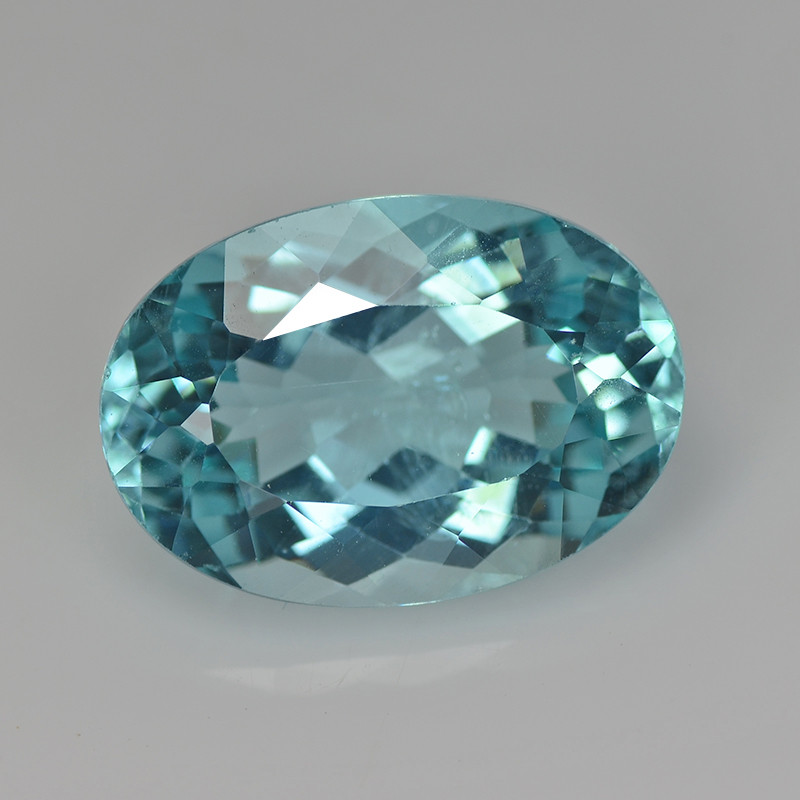
“Apatite” kyerɛ aboɔden abo kuw bi anaa aboɔden abo ankorankoro bi a ɛwɔ saa kuw no mu. Ɔbo no kɔla ahorow gu ahorow, nanso apatite agude a wonim no yiye no yɛ Caribbean bruu anaa neon bruu-ahabammono a ɛma yɛkae Paraiba tourmaline.
Wɔ aboɔden abo mu no, apatite ne gyinapɛn a wɔde yɛ 5 wɔ Mohs hardness scale no so .
Azurite a wɔde yɛ nneɛma

Azurite yɛ ɔbo bruu a agye din a ɛyɛ fɛ a ɛwɔ abakɔsɛm mu ntease sɛ ɛyɛ bruu a wɔde yɛ ade. Nhwɛsoɔ baako a ɛda nsow ne Renaissance mfonini Madonna ne Abofra a Wɔde Ahotefoɔ Atena Ahengua a Raphael yɛeɛ no.
Ɔbo no bruu no betumi ayɛ soronko wɔ nea ɛyɛ fitaa, ɛyɛ hyew, anaa ɛyɛ tuntum mu. Nanso, azurite kɔla taa yɛ ahabammono bere a ɛdannan malachite no . Aboɔden abo pii yɛ abien no nyinaa a wɔaka abom (azurmalachite), a ebetumi ayɛ kurukuruwa a wɔasen a ɛte sɛ Asase.
Nsu mu nsu mu aduru
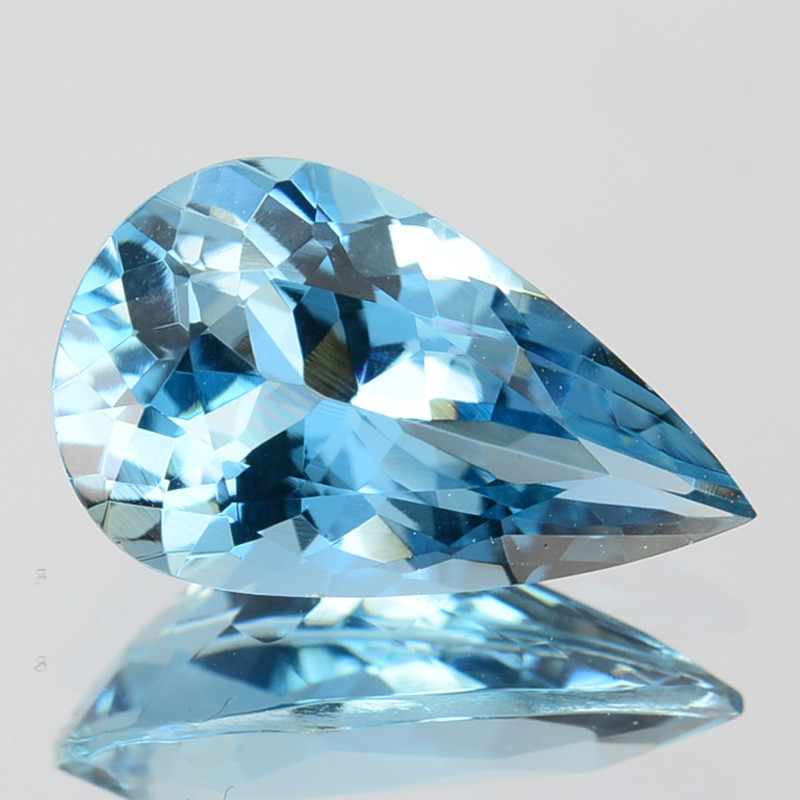
Awoɔ boɔ a ɛdi kan wɔ yɛn din mu, ma March nkokoaa , ne anansesɛm mu aquamarine, a ɛfiri (wɔ abakɔsɛm a wɔakyerɛw ato hɔ mu) bɛyɛ 480-300 A.Y.B. Wonim saa beryl ahorow yi sɛ ɛyɛ bruu a ɛyɛ mmerɛw kosi nea emu dɔ ne bruu-ahabammono ahorow. Dodow no ara yɛ ahabammono-blue a ɛyɛ hare.
Kɔla bɛn na aquamarine bo yɛ den sen biara? Aquamarines a ɛsom bo sen biara no wɔ kɔla bruu a emu yɛ den na ɛho tew. Ɔhyew a wɔde sa yare no taa yɛ de tew nne a ɛyɛ ahabammono so.
Dɛn ne abo bruu a wɔntaa nhu? Wɔn mu baako ne...
Benitoite na ɔkyerɛwee
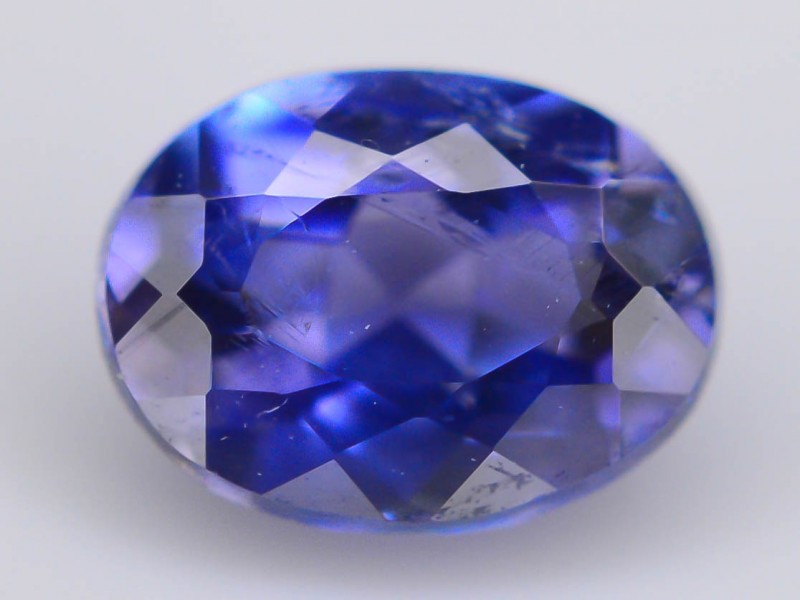
Ɛnyɛ aboɔden abo a ɛyɛ bruu sen biara no mu biako nko, na mmom benitoite nso yɛ aboɔden abo bere a ɛho yɛ na sen biara no mu biako. Dɛn nti na benitoite ho yɛ na saa? Wohu saa aboɔden abo a ɛyɛ bruu a ɛyɛ safir, bruu a ɛyɛ violet, anaa nea enni kɔla yi sɛ ahwehwɛ a ɛte sɛ aboɔden abo wɔ California beae biako (San Benito) a wɔyɛ bɛyɛ carat 300 afe biara nkutoo.
Benitoite ogya a ɛhyerɛn (dispersion) nso boro daimond de so (a ne bo yɛ mmerɛw), na benitoite kɔla bruu no mfiase pɔtee no da so ara yɛ ahintasɛm, ɛmfa ho nhwehwɛmu pii a wɔayɛ no.
Chalcedony a ɛyɛ bruu

Chalcedony ka quartz abo a ɛyɛ microcrystalline kuw kɛse bi ho. Sɛ agate nka ho a, bruu ahorow no bi ne:
Blue Chalcedony : Ahorow a wɔakyerɛw so kɛkɛ sɛ “chalcedony” no taa yɛ nea ɛyɛ hann na ɛyɛ kɔla a ɛyɛ den a ɛyɛ bruu, fitaa, anaa violet bruu.
Aquaprase : Ɔboɔ foforɔ a wɔahu a wɔhunuu wɔ afe 2014 mu, saa ɔboɔ yi yɛ bruu-ahabammono na wɔtɔn no sɛ AquapraseTM berɛ a ɛyɛ abɔdeɛ, wɔansa, na Avant Chordia na ɛkyekyɛ
Chrysocolla Chalcedony (Gem Silica) : Chalcedony ahorow a ɛsom bo sen biara, saa ahorow yi wɔ kɔla bruu-ahabammono a ɛhyerɛn ne/anaasɛ bruu a efi chrysocolla nketenkete a wɔde aka ho mu .
Jasper : Ɛwom sɛ ɛntaa nsi de, nanso ɛtɔ mmere bi a jasper bruu ahorow ne po mu jasper, kambaba jasper, ne imperial jasper
Mpɛn pii no, mmeae a wonya fibea bɔ wɔn chalcedonies bruu pɔtee no din, te sɛ “Mojave blue” a efi California, “African blue” a efi Namibia, anaa “holly blue” a efi Oregon.
So chalcedony bruu ho yɛ na? Asinasin a ɛte sɛ aboɔden abo no ntaa mma. Abɔde mu kɔla a ɛyɛ pɛ, bruu a emu dɔ ne chalcedony kɔla a ɛntaa nsi.
Chrysocolla a wɔfrɛ no chrysocolla

Dɛn ne ɔbo bruu a ɛyɛ hann a ɛte sɛ turquoise no ? Ebia woresusuw chrysocolla, kɔbere carbonate a ɛwɔ kɔla bruu kosi ahabammono na mpɛn pii no ɛyɛ tuntum (a ɛma ɛda nsow wɔ turquoise ho) ho.
Ɛwom sɛ ɛyɛ mmerɛw de, nanso chrysocolla yɛ kɔbere a ɛho hia na sɛ wɔde fra abo afoforo a, ɛyɛ aboɔden abo a ɛyɛ fɛ.
Nhwɛso biako a ɛho hia ne Eilat ɔbo a chrysocolla, turquoise, ne malachite (ne aboɔden abo afoforo) wom no. Ɛyɛ Israel ɔman ɔbo na wɔtoo no din “Ɔhene Salomo Ɔbo.”
Blue Diamond a ɛyɛ bruu
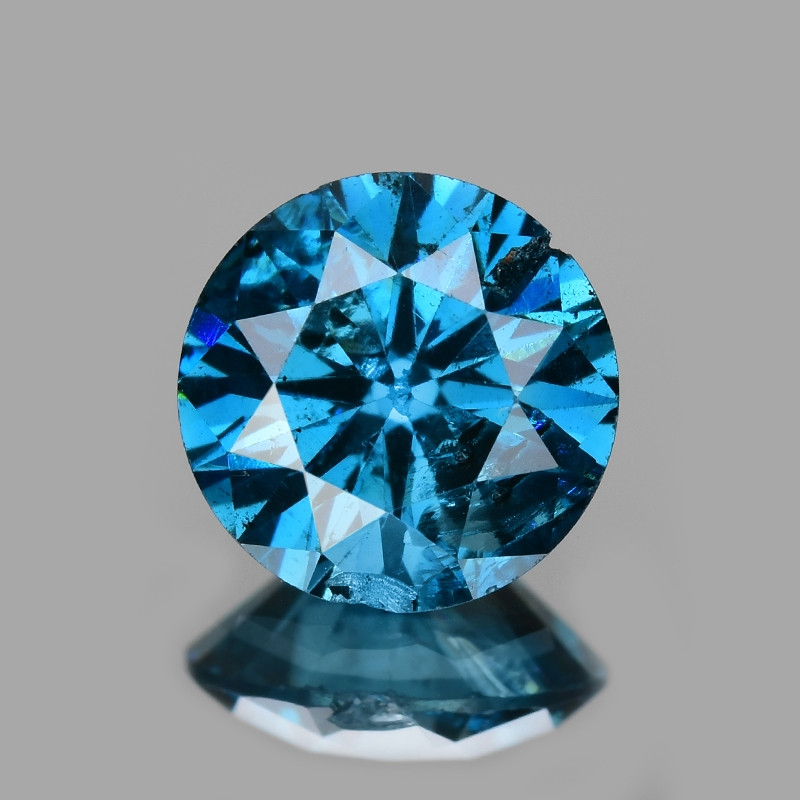
Aboɔden abo nyinaa aboɔden abo, daimond no nkamfo di n’anim. Nanso so abohene bruu yɛ ade ankasa? Yep, diamond bruu wɔ hɔ fi awosu mu. Ɛwom sɛ ɛnyɛ diamond kɔla a ɛho yɛ na sen biara , nanso diamond a ne bo yɛ den sen biara wɔ wiase no bi yɛ bruu:
Hope Diamond : Diamond a ne bo yɛ den sen biara a ɛto so 3, ne bo bɛyɛ U.S. dɔla ɔpepem 350 (bɛboro dɔla ɔpepem 7 wɔ carat biara mu) de besi March 2023
Oppenheimer Blue Diamond : Diamond a ne bo yɛ den sen biara a ɛto so 7, wɔtɔn no US dɔla ɔpepem 57.5 (bɛboro dɔla ɔpepem 4 wɔ carat biara mu) wɔ afe 2016 mu
Blue Moon of Josephine Diamond : Diamond a ne bo yɛ den sen biara a ɛto so 10, wɔtɔn no US dɔla ɔpepem 48.4 (bɛyɛ dɔla ɔpepem 4 wɔ carat biara mu) wɔ November 2015 mu
Nokwarem no, abohene bruu da so ara yɛ abohene, a ɛkyerɛ sɛ ɛyɛ aboɔden abo a ɛsom bo nso , April awo abo , ne atetesɛm mu aboɔden abo a wɔde di ayeforohyia afe a ɛto so 10, 60, ne 75 , a nea ɛka ho ne sɛ ɛyɛ ade a ɛyɛ den sen biara wɔ wiase.
Dumortierite na ɔkyerɛwee
 Mfonini a ɛwɔ atifi hɔ no: Dumortierite a wɔde quartz ayɛ
Mfonini a ɛwɔ atifi hɔ no: Dumortierite a wɔde quartz ayɛ
Dumortierite yɛ borosilicate a ɛtaa yɛ bruu, bruu a ɛyɛ ahabammono, anaa bruu violet, ɛwom sɛ ebetumi ayɛ pink anaa kɔkɔɔ nso de. “Denim ɔbo bruu” yɛ abodin a wɔde frɛ dumortierite bruu a emu dɔ.
Aboɔden abo a wonnim no pii, wonim no yiye sɛ ɛyɛ nea ɛma “dumortierite quartz” yɛ bruu, efisɛ saa quartz yi wɔ dumortierite a ɛka ho ahorow.
Ɛtɔ mmere bi a wɔfrɛ no “Bahia Blue Quartz” anaa “Blue Moon Quartz,” na ɛsono sɛnea ɛte. Nhwɛsode ahorow bi mu da hɔ pefee a wɔde dumortierite nnade bruu (te sɛ rutilated quartz) bere a nea ɛka ho wɔ nhwɛso afoforo mu no te sɛ akorade abon.
Wɔnnye nea ɛde dumortierite kɔla bruu ba no ntom koraa.
Nsusuwii ahorow a edi kan kae sɛ bruu no fi dade a ɛyɛ dade (Fe2+) ne titanium (Ti4+) charge transfer mu. Akyiri yi nnuru mu nhwehwɛmu kyerɛe sɛ na magnesium a ɛwɔ dumortierite a enni kɔla mu no dɔɔso kɛse, enti nyansahufo binom susuw sɛ magnesium a ɛboro so yi ne titanium no bom mmom, enti titanium a ɛdɔɔso nni hɔ a ɛbɛka a ɛne dade abɔ na ayɛ kɔla bruu no.
Fluorite a Ɛyɛ Bruu
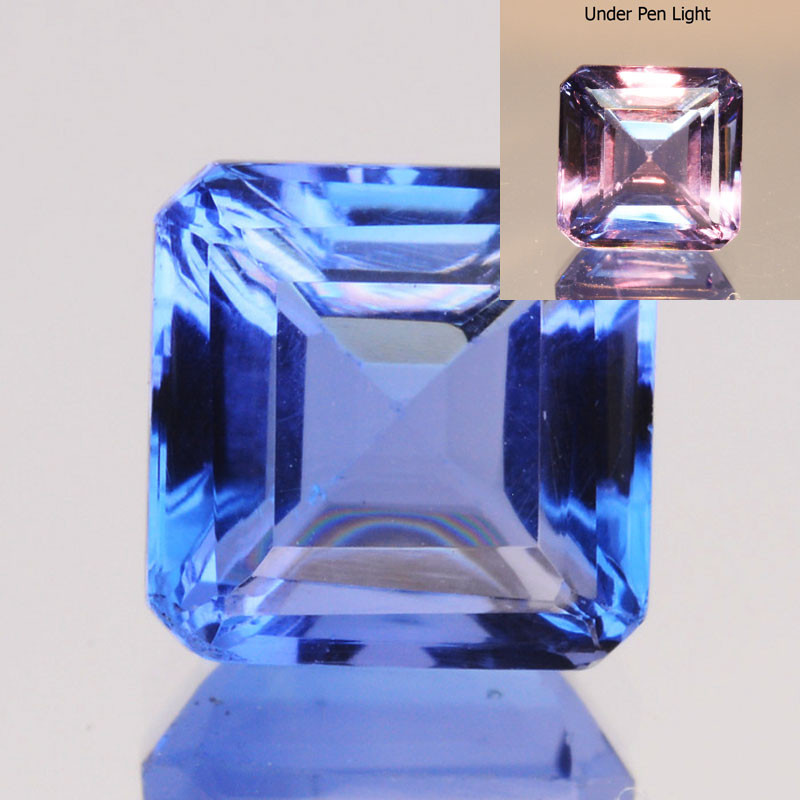
Wonim fluorite sɛ ɛwɔ kɔla ahorow a ɛsen biara wɔ aboɔden abo biara mu, nanso fluorite kɔla biako a wɔntaa nhu a wɔhwehwɛ ne bruu. Ebia fluorite bruu no kɔla ahorow, ne kɔla sesa (ɛdan fi bruu anaa teal kɔ lilac anaa ahabammono wɔ kanea soronko mu), anaasɛ ɔkwan titiriw bi a wɔfrɛ no “Blue John.”
“Blue John Stone” anaa “Derbyshire Spar” yɛ fluorite a wɔntaa nhu a efi Treak Cliff Cavern ne Blue John Cavern a ɛwɔ Derbyshire, England nkutoo mu. Ɛwɔ kɔla a ɛyɛ kɔkɔɔ-blue ne kɔkɔɔ a wɔde abɔ so.
Granddidierite a ɛyɛ den
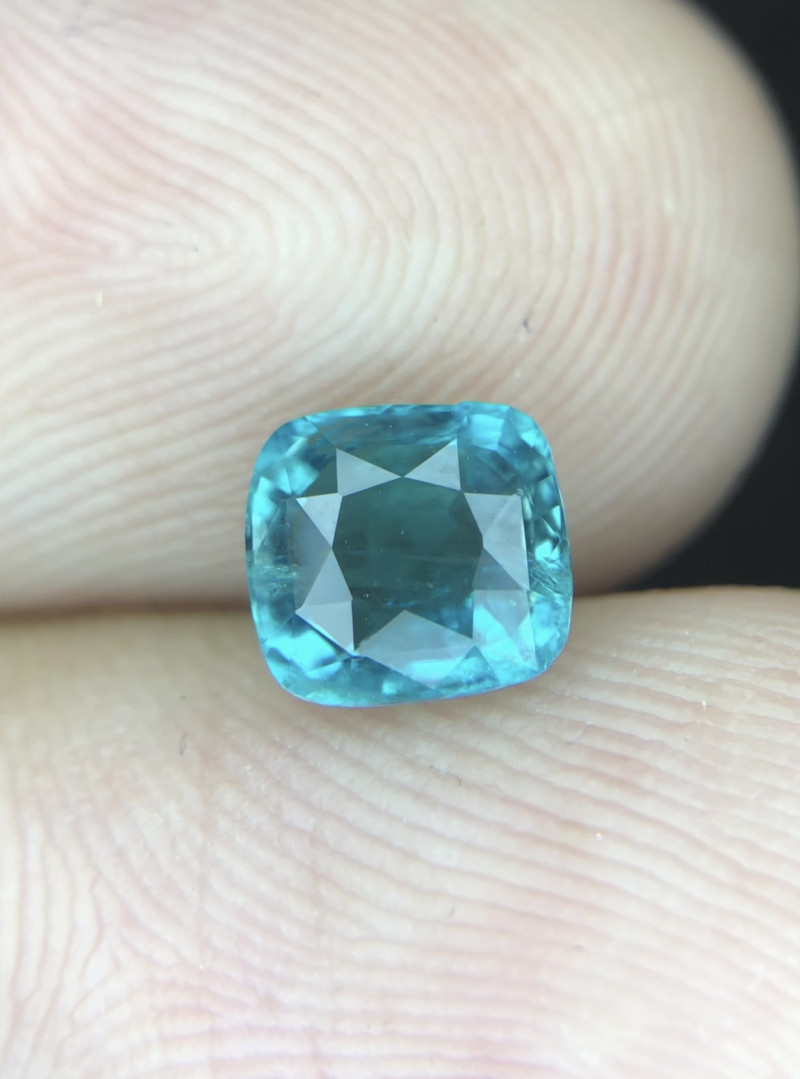
Te sɛ benitoite no, grandidierite ka aboɔden abo a wɔntaa nhu wɔ wiase no ho. Grandidierite yɛ aboɔden abo a ɛyɛ bruu te sɛ aquamarine kosi po mu ahabammono, na dade a ɛdɔɔso a ɛwɔ mu no kyerɛ sɛ wɔde kɔla bruu pii bɛma.
Ɔbo no wɔ bruu, bruu-ahabammono, anaa ahabammono nkutoo mu. Nanso, ɛwɔ pleochroism a emu yɛ den (kɔla ahorow a ɛsono sɛnea wotumi hwɛ) nso wɔ ahabammono tuntum, bruu-ahabammono tuntum, ne kɔla a enni kɔla anaasɛ kɔkɔɔ a ɛyɛ hann mu.
Sɛ yɛhwɛ granddidierite bo a, grandidierite a edi kan a ɛda adi pefee, a ɛwɔ afã horow no gyee bɛyɛ dɔla 172,000 wɔ carat biara mu, nanso mpɛn pii no abo a ɛwɔ anim a ɛyɛ papa no yɛ dɔla 20,000 kosi dɔla 26,000 wɔ carat biara mu. Cabochons yɛ nea ne bo yɛ den kɛse.
Hawk Aniwa a Wɔde Yɛ Adwuma

Hawk aniwa yɛ aboɔden abo a ɛyɛ titanium-blue kosi bruu-ahabammono a mfiridwuma mu no ɛyɛ ɔbotan ne quartz pseudomorph, efisɛ efi ase sɛ crocidolite (asbestos bruu) a ɛsakra kɔ quartz nanso ɛkɔ so yɛ nhama.
Nhwɛsode ahorow a dade ayɛ ho fĩ bere a wɔreyɛ no bɛyɛ ɔsebɔ aniwa abo a ɛyɛ sika kɔkɔɔ-biribiri. Sɛnea ɛte no, ɛtɔ mmere bi a wɔfrɛ ɔkraman aniwa “blue tiger’s eye.”
Fibrous nhyehyɛe no ma hawk’s eye simple chatoyancy, optical effect a ɛte sɛ “cat’s eye” effect nanso sɛ́ anka hann ray biako a ɛdannan no, hann streaks pii wɔ hɔ.
Hemimorphite a ɛwɔ nipadua no mu
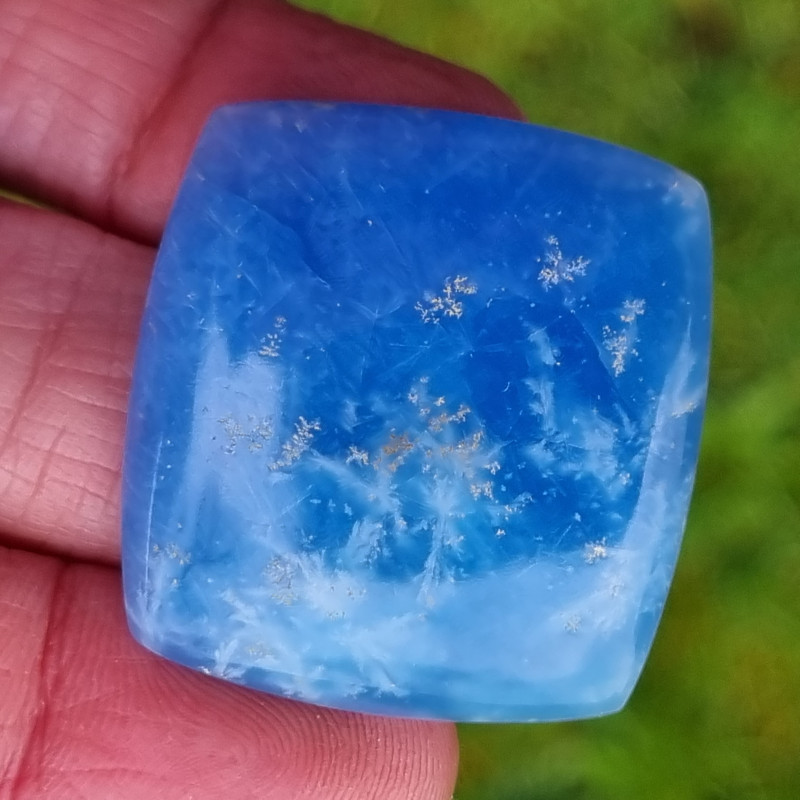
Hemimorphite yɛ aboɔden abo a ɛntaa nsi, ɛtaa yɛ fitaa, fitaa, anaa bruu nanso ne robin’s egg blue anaa bruu a ɛhyerɛn no yɛ nea wɔn a wɔboaboa ano no ani gye ho. Nanso, su titiriw pii wɔ hɔ a hemimorphite kɔla no ka ho.
Dɛn na ɛyɛ soronko saa wɔ hemimorphite ho? N’awiei (ahwehwɛ no awiei a ɛda hɔ gyina hɔ). Sɛ́ anka ɛbɛyɛ sɛ dodow no ara yɛ pɛ wɔ n’awiei abien no nyinaa so no, hemimorphite ahwehwɛ no bɛyɛ nea ɛyɛ mmerɛw na ne fã kɛse no ara bɛyɛ anim biako wɔ n’awiei biako a ne nsusuwii yɛ pyramidal, a ɛyɛ nsensanee kɛse wɔ ɔfã foforo. Eyi nti na wɔde Hela asɛmfua hemi, a ɛkyerɛ “fã” ne morph, a ɛkyerɛ “nsusuwii” na ɛtoo no.
Hemimorphite nhwɛsode dodow no ara wɔ bruu ne fitaa banding anaa mottling bi. Esiane sɛ hemimorphites a ɛyɛ bruu a ɛyɛ den ho yɛ na titiriw nti, adetɔnfo binom a wɔyɛ sunsuma bɛhyɛ aragonite bruu ma atwam sɛ hemimorphite bruu.
Bio nso, wɔtaa de hemimorphite fra smithsonite , zinc ade foforo a ɛte sɛ nea ɛte saa ara.
Iolite a wɔde yɛ nneɛma
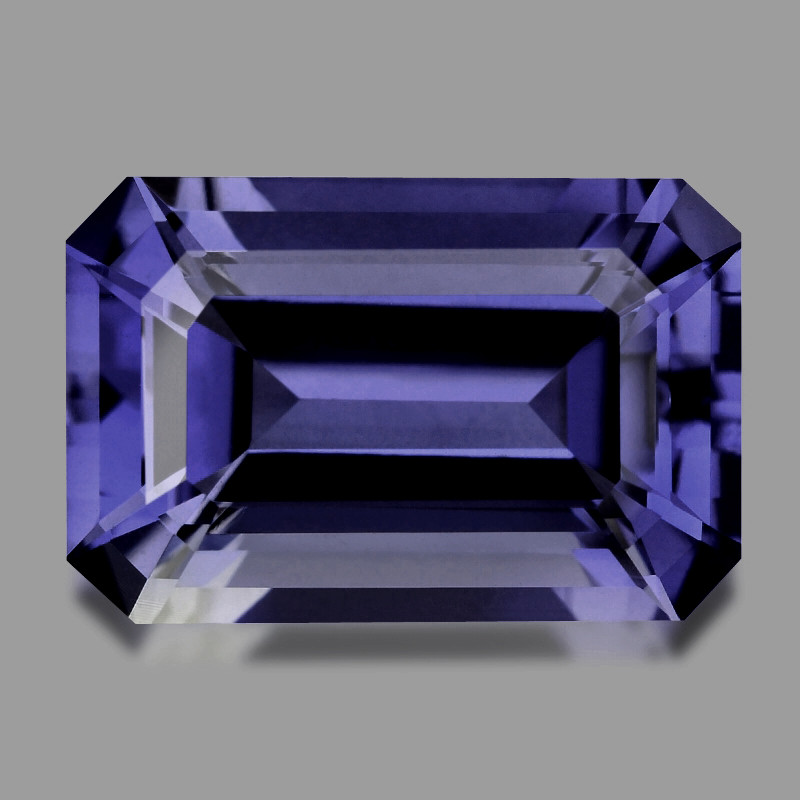
Ɛwom sɛ wɔde Hela asɛmfua ios , a ɛkyerɛ “violet” na ɛtoo iolite din de, nanso nokwarem no, ɛyɛ cordierite a ɛyɛ violet-blue. Iolite kɔla ahorow a ɛsom bo sen biara ne bruu a ɛyɛ violet kakra ne bruu a ɛho tew, a dade efĩ na ɛde ba. Nneɛma afoforo a ɛda nsow ne ne trichroism a emu yɛ den (pleochroic kɔla abiɛsa) ne sɛnea ɛtɔ mmere bi a etumi da chatoyancy anaa aventurescence adi.
Iolite mfiase a agye din sen biara ne anansesɛm a ɛkyerɛ sɛ anka Vikingfo benya iolite a wɔde bɛfa po so, na wɔde emu asinasin adi dwuma de ahu owia (na ɛnam so ama baabi a wɔwɔ) wɔ nna a mununkum akata so.
Wɔ nnɛyi mmere yi mu no, iolite yɛ nsoromma mu hwɛ bo ma Sagittarius ne ayeforohyia afe a ɛto so 21 abohene.
Jadeite a ɛyɛ bruu
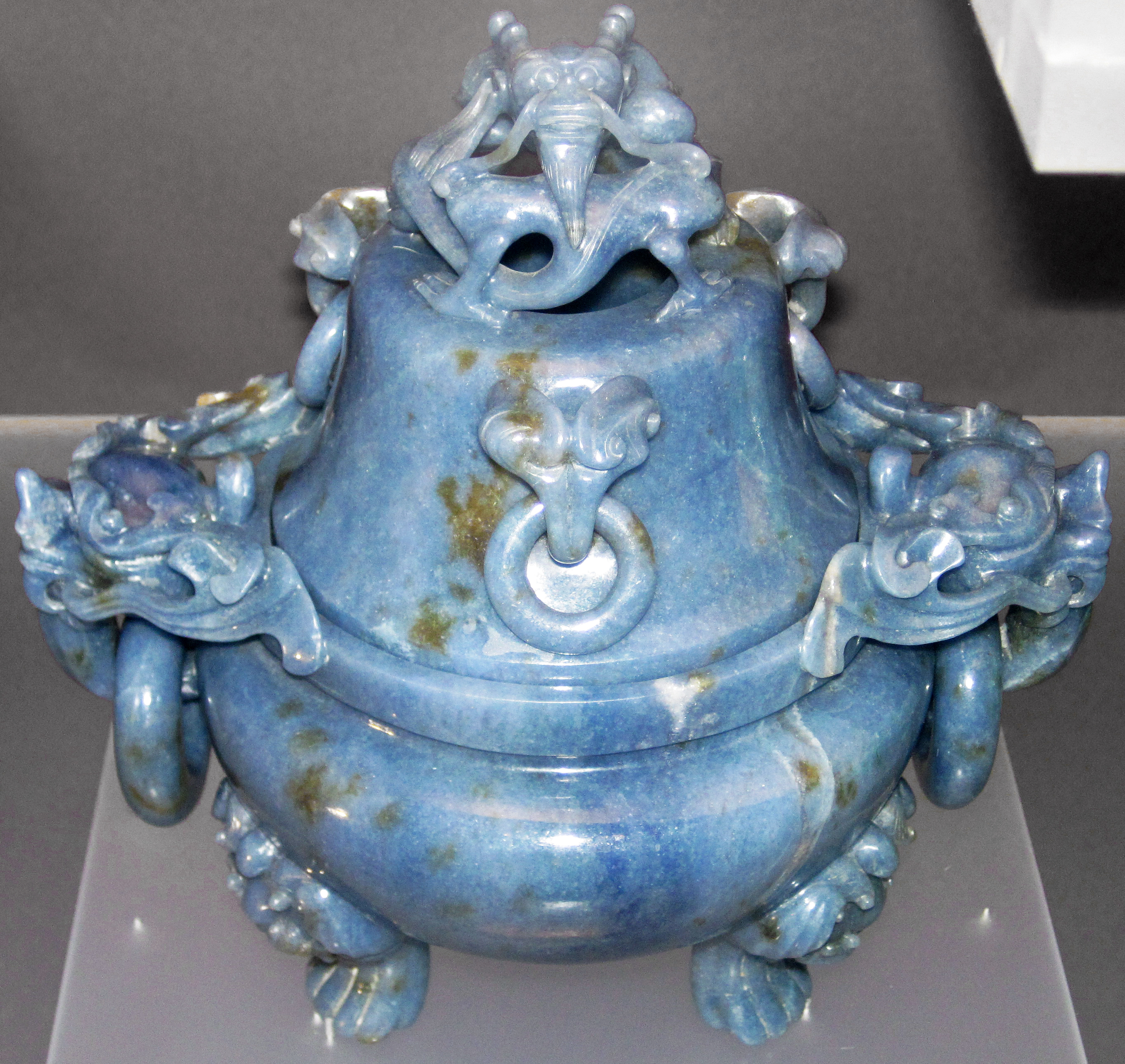 Mfonini a ɛwɔ atifi hɔ no: Blue jadeite Chinafo aduhuam hyew a efi Qing Ahemman | Mfonini no fi: James St. John, CC-BY-SA-2.0
Mfonini a ɛwɔ atifi hɔ no: Blue jadeite Chinafo aduhuam hyew a efi Qing Ahemman | Mfonini no fi: James St. John, CC-BY-SA-2.0
Jadeite yɛ aboɔden abo abien (ne nephrite) a wɔfrɛ no “ jade ” no mu biako. Wonim nephrite ne jadeite aboɔden abo nyinaa yiye sɛ aboɔden abo a ɛyɛ ahabammono , nanso jadeite wɔ kɔla ahorow a ɛhyerɛn na ɛtrɛw. Jadeite kɔla a wɔntaa nhu, a wonhu nso wɔ nephrite mu no yɛ bruu.
Dɛn ne jadeite a ɛyɛ bruu? Ɛyɛ abɔde mu jadeite a ɛntaa nsi a ɛtaa yɛ bruu a ɛte sɛ nufusu, nanso ebetumi nso ayɛ bruu a ɛyɛ mfinimfini anaa bruu-ahabammono a ɛyɛ mmerɛw.
Ɔkwan biako a agye din ne “Olmec blue jadeite.” Ná Olmecfo, Mesoamerican anibuei a edi kan a na ɛwɔ hɔ bɛyɛ afe 1600 kosi 400 A.Y.B. Wɔ Olmecfo fam no, na jadeite bruu yɛ foforoyɛ, nkwa, ne onyin ho sɛnkyerɛnne, na tete Mayafo gyee obu yi toom.
Mayafo wɛn jadeite fibea ahorow no kosii sɛ wowuwui, na ɛyɛ 1970 mfe no mu kosi 2000 mfe no mfiase na wɔsan huu Olmec blue jadeite wɔ Guatemala.
Jeremejevite na ɔkyerɛwee
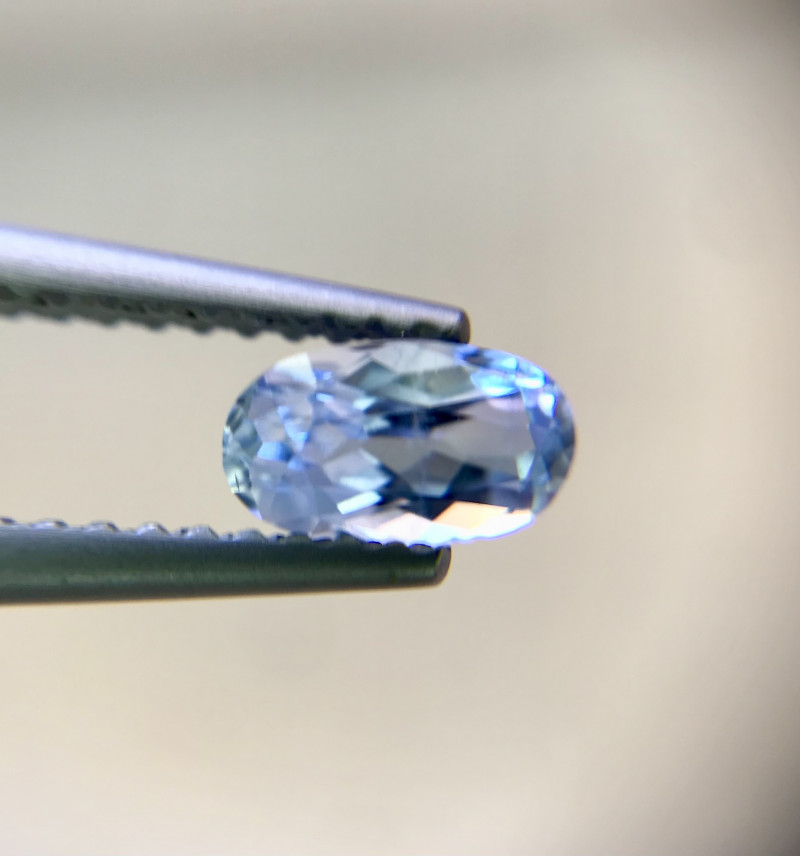
Jeremejevite (wɔbɔ no yer-ah-mee-YAY-vite) yɛ aboɔden abo a ɛho yɛ na a ne kɔla yɛ mmerɛw a wɔn a wɔboaboa ano no dɔ wɔ ne kɔla bruu a ɛyɛ bruu kosi bruu-ahabammono mu. Wohuu no wɔ Russia wɔ 1883 mu, nanso wohuu ahwehwɛ a edi kan a ɛwɔ anim (a na ɛyɛ bruu-ahabammono) wɔ Namibia wɔ 1973 mu.
Sɛ yɛrekyerɛ sɛnea jeremejevite ho yɛ na no dodow a, nsɛm pii a wɔahyehyɛ no ka wɔn aboɔden abo 10 a ɛho yɛ na sen biara no ho. Aboɔden abo a ɛwɔ afã horow no ho yɛ na koraa, titiriw nea ɛboro carat 1. Ahwehwɛ nketewa (a wɔantwitwa) mpo fi ase bɛyɛ dɔla 60.
Wɔ bruu akyi no, jeremejevite kɔla ahorow no nso bi ne kɔla a enni kɔla, hann anaa sika kɔkɔɔ-kɔla, kɔkɔɔ-biribiri, ahabammono a ɛyɛ hann, ne violet.
Kyanitefoɔ
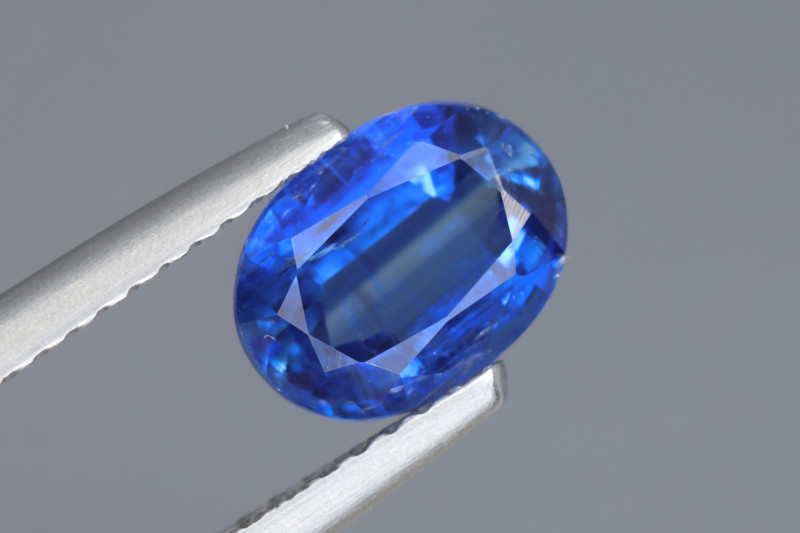
Aboɔden abo a abu so kakra nanso ɛho yɛ na, kyanite yɛ nea nkurɔfo ani gye ho kɛse (na wɔtaa hu) wɔ kɔla bruu mu. Kyanite bruu ahorow no fi nea ɛyɛ mmerɛw kosi tuntum, na nhwɛsode pii wɔ nsensanee a ɛyɛ fitaa ne bruu, na mpɛn pii no bruu a emu dɔ yɛ nsensanee wɔ ahwehwɛ no mfinimfini.
Nsɛmfua afoforo a wɔde frɛ kyanite ne “cyanite” ne “disthene.” Mfiridwuma mu kyanite a wɔde di dwuma no dɔɔso. Nneɛma a wɔde di dwuma titiriw ne nneɛma a wɔde yɛ ɔhyew (baabi a wɔyɛ dɔte) ne nneɛma a wɔde yɛ ɛlɛtrɔnik mfiri.
Honhom fam no, wɔde kyanite bruu di dwuma de bɔ wɔn ho ban, ahoɔden, ne nkitahodi.
Labradorite a wɔde yɛ adwuma
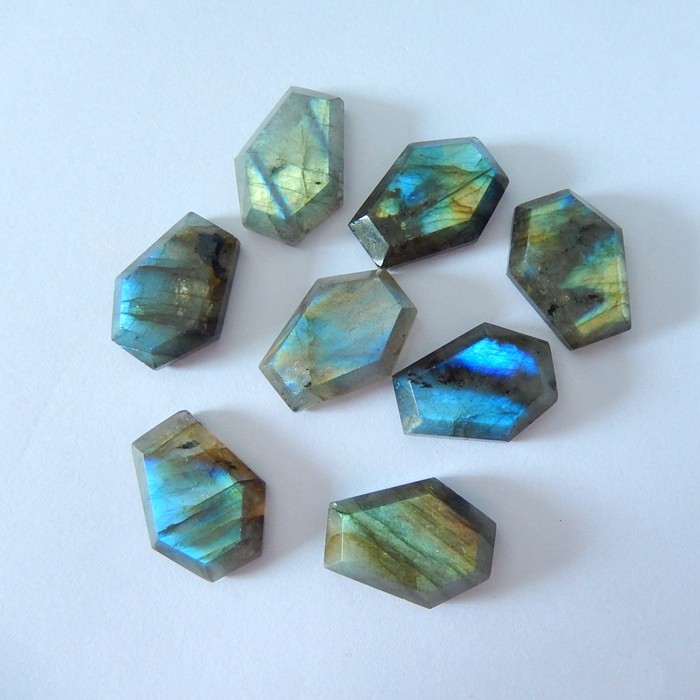
Labradorite yɛ feldspar ahorow a ɛyɛ nwonwa a ɛda nsow sɛ ɛtaa da ne eponymous labradorescence, iridescence bi a kɔla ahorow pii a ɛhyerɛn no adi. Blues a ɛhyerɛn ne borɔdɔma ne labradorite kɔla a ɛtaa hyerɛn sen biara.
Wɔfrɛ ahorow ahorow bi a wonim sɛ ɛkame ayɛ sɛ ɛyɛ nea ɛda adi pefee a ɛhyerɛn bruu a ano yɛ den no “nyankontɔn ɔsram bo.” Wubetumi nso ahu bruu a ɛhyerɛn, ne kɔla foforo biara a ɛwɔ nyankontɔn no mu, wɔ Finlandfo labradorite ahorow a wɔntaa nhu a wɔfrɛ no spectrolite mu .
Lapis Lazuli na ɔkyerɛwee

Lapis lazuli (anaa lapis) yɛ ɔbotan bruu a emu dɔ a ɛyɛ adehye de a ɛtaa yɛ nsensanee a calcite fitaa ne sika kɔkɔɔ pyrite ka ho. Aboɔden abo titiriw a ɛwɔ hɔ ne lazurite (anaasɛ ne su hauyne), sodalite a emu dɔ a ɛyɛ bruu a ɛyɛ ultramarine.
Saa ɔbo yi ne mfitiase “blue” no, sɛnea ɛyɛ bruu a edi kan a wonim no fibea a efi abodan mu mfonini ahorow a wɔyɛe wɔ nnɛyi Afghanistan bɛyɛ afe 400 kosi 700 Y.B. Wɔ mfehaha pii mu no, na tete Misrifo nkutoo na wonim sɛnea wɔyɛ saa aduru a ɛyɛ bruu yi; nokwarem no, na wɔn nkutoo ne tete amammerɛ a na asɛmfua bi wɔ hɔ ma “blue.”
Lapis aduru a wɔde yɛ “ultramarine” no gyee din wɔ Europa bɛyɛ afeha a ɛto so 12 mu, nanso ne bo boro sika kɔkɔɔ. Bere a wotumi nya no kɛse no, ɛbɛyɛɛ ade a ɛyɛ nwonwa, titiriw wɔ Kristofo Renaissance mfonini ahorow mu.
Ɛnnɛ, lapis lazuli yɛ September awobo ne atetesɛm mu ayeforohyia afe a ɛto so 9 abohene.
Larimar na ɔkyerɛwee
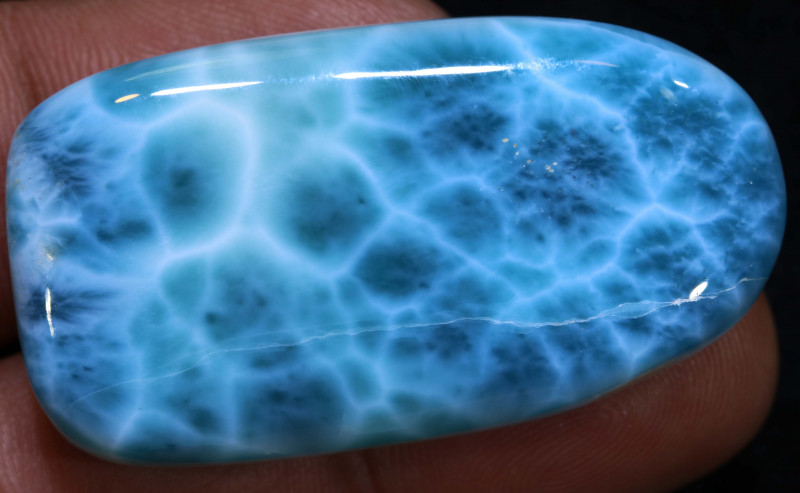
Nea ɛka aboɔden abo a wɔntaa nhu no ho ne larimar, ɔbo a ɛyɛ po mu ahabammono kosi bruu a ɛyɛ hann a ɛwɔ nsusuwso fitaa a mununkum wom. Dominican Republic nkutoo na wohu Larimar. Larimar kɔla a agye din paa ne wim bruu, nanso kɔla a wɔntaa nhu, na ɛsom bo sen biara ne bruu a emu dɔ a wɔfrɛ no “ogya bepɔw bruu.”
Ɛkame ayɛ sɛ larimar biara wɔ nsusuwso bi, na nea eye sen biara ne bruu a emu dɔ a wɔde nhama fitaa ayɛ. Nea ɛtaa ba ne nsensanee fitaa anaa pectolite a ɛyɛ nsensanee wɔ bruu nnyinaso so.
Sɛ woasusuw ho a , dɛn ne aboɔden abo a ɛyɛ bruu a wɔfrɛ no baby blue no? , ebia ɛbɛyɛ larimar, nanso ebetumi ayɛ ɔsram abo.
Ɔsram Abo

Moonstone yɛ feldspar ahorow a ɛtaa yɛ hann a ɛwɔ kɔla ahorow kakraa bi, nanso nea eye sen biara, a ɛsom bo sen biara no wɔ nnyinaso a enni kɔla, biribiara nka ho, na ɛyɛ bruu a ɛyɛ mfinimfini. Wɔfrɛ saa heen anaa “flash” yi adularescence, a ɛte sɛ nea ɔbo no fi mu hyerɛn.
Sɛ yɛhwɛ bo a ɛsom a, so ɔsram abo a ɛyɛ bruu ho yɛ na? Bere a ɔsram abo akɛse a ɛyɛ fɛ a ɛwɔ kɔla biara ho yɛ na koraa no, ɔsram abo a ɛyɛ bruu no ntaa nyɛ kɛse nsen carat 15-20. Hwɛ yiye: adetɔnfo a wonni nokware no bi bɛkyerɛw chalcedony a wɔayɛ no bruu a wɔayɛ no sɛ “ɔsram abo bruu.”
Ɔsram abo yɛ June awo abo foforo ne Kokoram sɛnkyerɛnne talismans a ɛyɛ anigye.
Blue Opal a ɛyɛ bruu
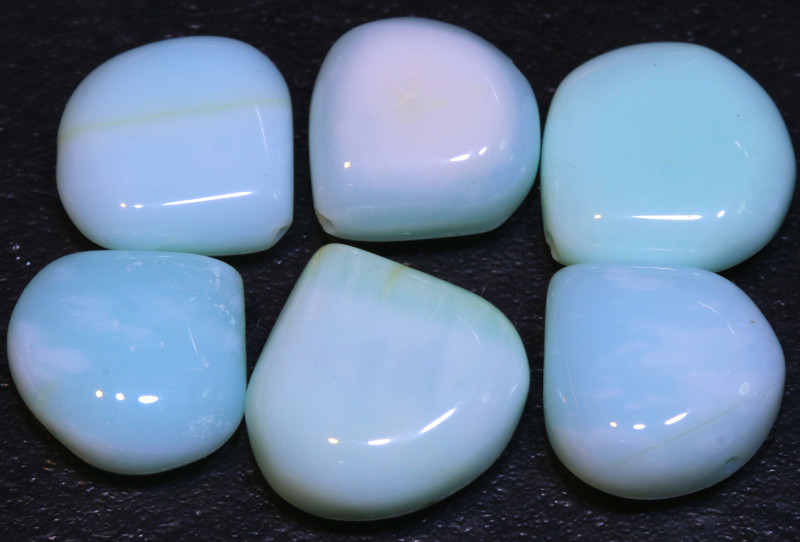
Sɛ opals yɛ October awo abo ne mineraloids (ɛnyɛ minerals) da nkyɛn a, ɛyɛ soronko na ɛsõ wɔ ne ahorow mu.
Akuw atitiriw abien no ne opals a wɔtaa de di dwuma (enni iridescent-te sɛ play-of-color) ne opals a ɛsom bo (yɛwɔ play-of-color). Mpɛn pii no, wɔnhwehwɛ opal a wɔtaa de di dwuma kɛse, nanso biako a ɛka ho ne blue common opal .
Opal bruu a wɔtaa bu no kɛse ho nhwɛso a agye din ne Peru opal , Peru ɔman ɔbo a ɛyɛ mmerɛw a ne kɔla yɛ teal. Ɔkwan foforo a ɛda nsow ne Owyhee opals a efi Oregon, a ɛwɔ bruu a ɛyɛ mum a ɛyɛ hann kosi tuntum.
Ne nyinaa akyi no, opal a ɛsom bo nso betumi ayɛ bruu. Ɛtɔ mmere bi a kɔla a ɛsom bo sen biara, opal tuntum, betumi anya nipadua kɔla bruu tuntum a ɛma ne nyankontɔn a ɛyɛ kɔla-agoru no hyerɛn ankasa.
Nhwehwɛ a Ɛyɛ Bruu
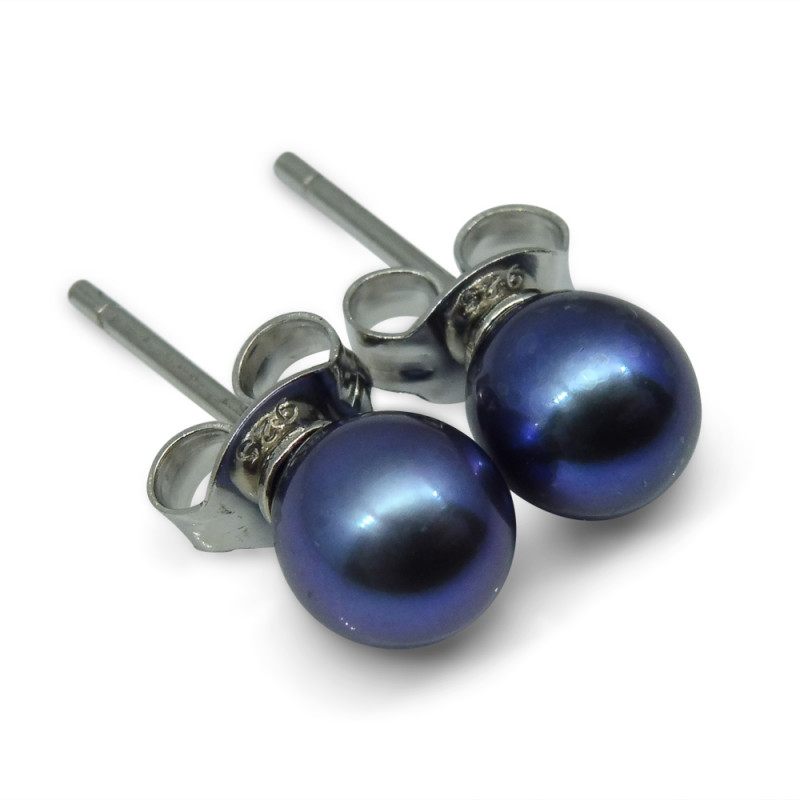
Wonim June awobo yi yiye sɛ ɛyɛ asonse kɔla, nanso ɛntaa mma, wubehu abɔde mu bruu wɔ nhwene ahorow te sɛ Akoya, Tahitian , anaa Kesee Fam Po mu nhwehwɛ mu.
Mpɛn pii no, blues no yɛ nnyigyei a ɛboro so, efi dwetɛ-blue (Kesee Fam Po) kosi wim bruu (Akoya) kosi anadwo fã bruu (Tahitian). Abalone nhwehwɛ a wɔayɛ no soronko no nso da bruu a ɛyɛ iridescence adi.
Sɛ da nkyɛn a ɛda nsow sɛ aboɔden abo a wɔmfa nnuru nni dwuma wom , ahwehwɛ bruu ho yɛ na koraa. Wɔde sika kɔkɔɔ ahwehwɛ bom sɛ abɔde mu kɔla ahorow a wɔntaa nhu.
Pietersite na ɔkyerɛwee
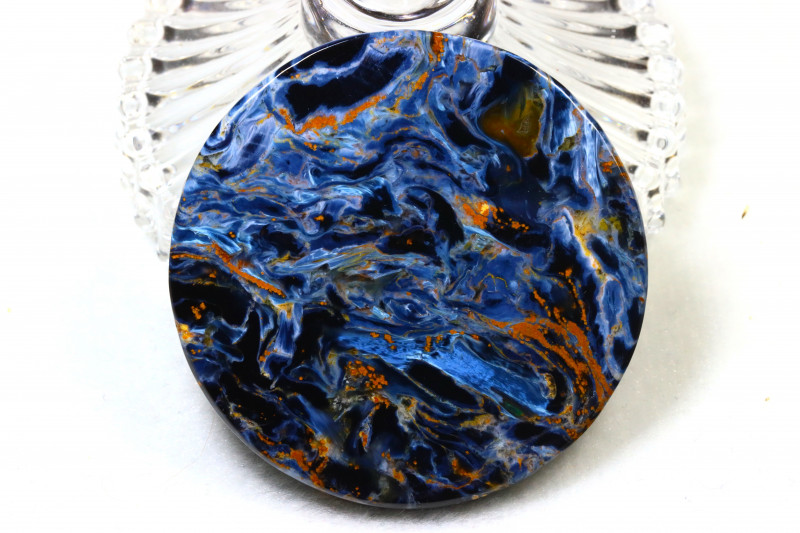
Pietersite yɛ ɔbo a ɛwɔ kɔla ahorow pii a wɔtaa frɛ no “ɔkɔre aniwa.” Chalcedony aggregate a wɔayɛ no nsusuwso no kura quartz sementing asinasin a ɛwɔ hawk’s eye ne tiger’s eye (mpɛn pii no), na ɛma wonya bruu, sika kɔkɔɔ, ne kɔkɔɔ a wɔde kyerɛ titiriw.
Pietersite biara wɔ nsusuwso soronko ne kɔla ahorow a wɔaka abom, ɛwom sɛ bruu ne bruu ne kɔla titiriw de. Te sɛ ne mfɛfo “ani” abo no, pietersite wɔ chatoyancy a ɛnyɛ den. Ná ɛyɛ ade a wohuu nnansa yi wɔ Namibia wɔ 1962 mu.
"https://www.gemrockauctions.com/sua/mfiridwuma-nsɛm-fa-aboɔden abo ho/blue-sapphires-nea-ɛma-sapphires-blue"> Blue Sapphire
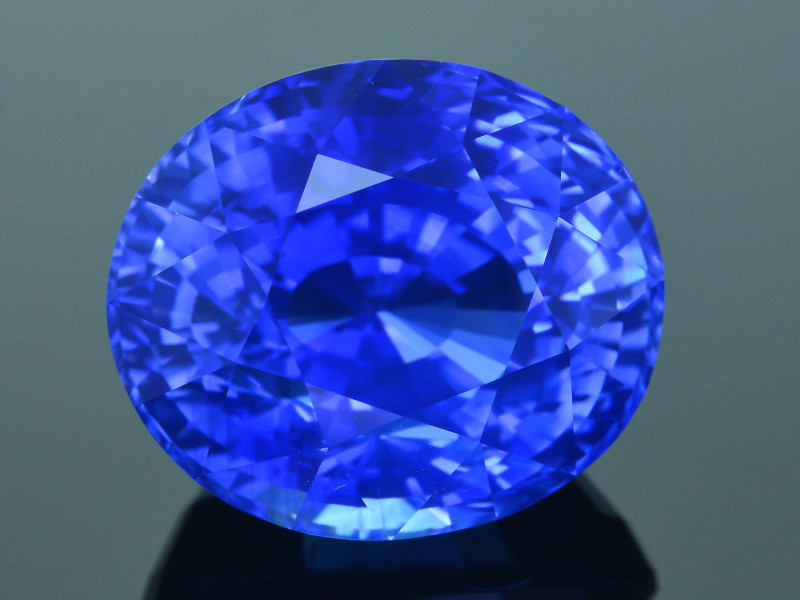
Akyinnye biara nni ho sɛ aboɔden abo bruu a agye din sen biara ne sapphire , corundum ahorow a wogye tom sɛ Ɔhene bruu aboɔden abo wɔ abakɔsɛm nyinaa mu. Bere a safir wɔ kɔla biara nanso ɛyɛ kɔkɔɔ (ɛno bɛyɛ ruby), safir bruu na agye din sen biara na ɛsom bo sen biara.
Safir bruu a eye sen biara ne atoko nhwiren bruu ne Kashmir, a ɛno nso yɛ atoko nhwiren bruu nanso ɛyɛ velvet na efi Himalaya mmepɔw so nkutoo.
Safir bruu ahorow afoforo a ɛda nsow:
Star Sapphire : Ɛda hann “nsoromma” a ɛwɔ mframa pii a ɛdannan adi; Dodow no ara yɛ tuntum, pink, anaa bruu, na bruu a ɛkorɔn sen biara na ne bo yɛ den sen biara
Mermaid anaa Peacock Sapphire : Teal sapphire a ɛyɛ bruu ne ahabammono 50-50
Safire a Ɛsakra Kɔla : Mpɛn pii no, ɛdannan fi bruu anaa kɔkɔɔ so awia hann kɔ violet anaa kɔkɔɔ-kɔla wɔ incandescence ase; Wɔtoo din wɔ ɔkwan a ɛnteɛ so sɛ “aleksandrite bruu” .
Dɛn na ɛyɛ soronko saa wɔ safir bruu ho? Sɛ wɔn abakɔsɛm ne nea egu ahorow da nkyɛn a, safir bruu yɛ abo a ɛtra hɔ kyɛ, na ɛyɛ ayeforohyia mpɛtea mfinimfini ɔbo a wɔtaa de di dwuma wɔ U.S. ansa na daimond rebɛyɛ nea wɔahyɛ da ayɛ.
Shattuckitefo na ɔkyerɛwee
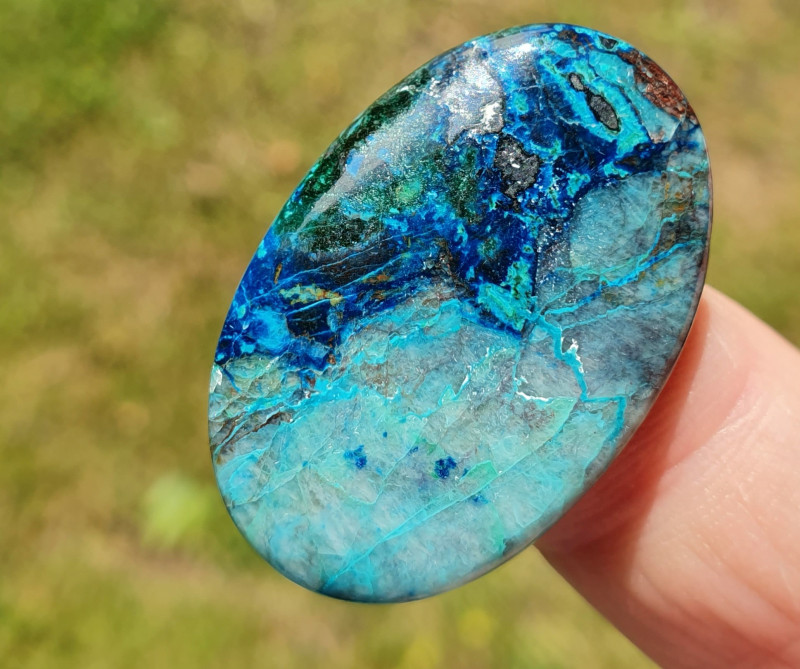 Mfonini a ɛwɔ atifi hɔ no: Shattuckite cabochon a ɛyɛ bruu a wɔde azurite, malachite, chrysocolla, ne cuprite ayɛ
Mfonini a ɛwɔ atifi hɔ no: Shattuckite cabochon a ɛyɛ bruu a wɔde azurite, malachite, chrysocolla, ne cuprite ayɛ
Wɔtoo shattuckite din esiane nea wohui wɔ Shattuck Mine a ɛwɔ Arizona, U.S.A., nti, ɛyɛ kɔbere abohene a wonim no sɛ ɛyɛ ahabammono anaa bruu, efi po so hyɛn mu kosi cobalt bruu a ɛyɛ dɛ so. Ebia wɔbɛfrɛ nhwɛsode ahorow a efi Congo no “Lunazul.”
Wɔtaa de shattuckite nhwɛsode fra abo afoforo te sɛ quartz, malachite, azurite, anaa chrysocolla. Chrysocolla vs shattuckite nso yɛ nsonsonoeɛ a ɛyɛ den a ɛtaa hwehwɛ sɛ wɔyɛ adwumayɛfoɔ nhwehwɛmu. Shattuckite cabochons pii wɔ nsensanee a ɛsono bruu, ahabammono, ne fitaa anaa tuntum.
Sodalite a wɔde yɛ nneɛma

Woresusuw ɔbo bɛn na ɛte sɛ lapis lazuli ho? Ebia ɛyɛ sodalite, denim, Prussia bruu, anaa violet-blue ɔbo a ne bo yɛ den a ɛtaa yɛ fitaa ne/anaasɛ bruu nsusuwso. Wɔ sodalite vs lapis lazuli ho no, nea etwa to no yɛ ɔbotan (ɛnyɛ mineral) na sodalite ahorow lazurite na ɛwɔ mu.
Wɔ mfiridwuma mu no, “sodalite” yɛ aboɔden abo kuw bi. Sodalite mineral ahorow bi te sɛ hackmanite , yɛ tenebrescent, a ɛkyerɛ sɛ ɛsakra kɔla wɔ owia mu na ɛsan kɔ esum mu.
Blue Spinel a ɛyɛ bruu
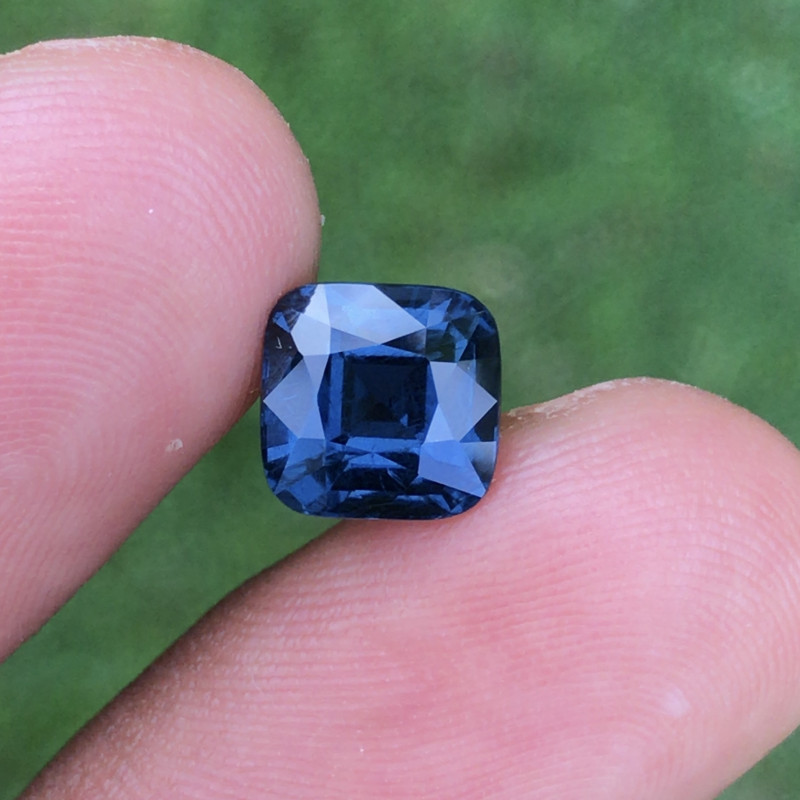
spinel a wɔde aka awoɔ aboɔ a wɔahyɛ da ayɛ ho (a wɔde kaa ho maa August wɔ afe 2016 mu) foforɔ koraa no, wɔhunu spinel wɔ kɔla ahodoɔ a ɛhyerɛn mu. Wɔ abakɔsɛm mu no, wodii mfomso buu no sɛ ɛyɛ rubi ne safir a ɛsom bo, nanso ɛwɔ n’ankasa bruu ahorow pii a ɛfata:
Gahnospinel : Bruu ne bruu tuntum a wɔde spinel ne gahnite afrafra
Pleonast : Bruu tuntum, tuntum, anaa ahabammono opaque ahorow
Alexandrite Spinel : Kɔla-sesa ahorow ahorow a ɛyɛ grayish-blue wɔ awia hann mu na violet wɔ incandescence ase; Hyɛ no nsow: ɛyɛ soronko wɔ alexandrite ho
Spinel bruu a ɛyɛ papa no yɛ cobalt bruu, a wobetumi ayɛ nso sɛ ogyaframa a wɔde frafra anaasɛ flux grown synthetics .
Afei, aboɔden abo bɛn na ɛyɛ bruu ne kɔkɔɔ?
Tanzanifo a wɔyɛ adwuma wɔ hɔ

Tanzanite yɛ epidote ahorow a ɛyɛ bruu, kɔkɔɔ, anaa violet-blue a wohu wɔ Tanzania nkutoo. Aboɔden abo no ho yɛ na dedaw, nanso sɛnea ɛte no, bruu nhwɛsode ahorow no ho yɛ na koraa, enti wɔde ɔhyew ayɛ tanzanite bruu dodow no ara ho adwuma.
So ɛsɛ sɛ tanzanite yɛ bruu anaasɛ kɔkɔɔ? Ebetumi ayɛ emu biara, nanso ne pleochroism a emu yɛ den no kyerɛ sɛ tanzanites a ɛwɔ afã pii bɛyɛ bruu ne kɔkɔɔ wɔ afã horow.
Te sɛ spinel no, tanzanite yɛ awo abo a wɔde aka ho nnansa yi nanso ɛyɛ December .
Topaz a ɛyɛ bruu
 Mfonini a ɛwɔ atifi hɔ no: London topaz aboɔden abo a wɔatwa no sɛnea wɔpɛ
Mfonini a ɛwɔ atifi hɔ no: London topaz aboɔden abo a wɔatwa no sɛnea wɔpɛ
December awobo foforo a ɛwɔ awɔw bere mu ne topaz bruu! Saa topaz yi yɛ ade a ɛdɔɔso kɛse, a ne bo nyɛ den a wɔde si tanzanite anaa safir bruu ananmu.
Topaz bruu ahorow bi wɔ hɔ a ɛsɛ sɛ wuhu, na wɔayɛ emu pii ho adwuma:
London Blue : Ɛyɛ fitaa a emu dɔ- anaa dade-blue; Mpɛn pii no, nea ne bo yɛ den sen biara; Ɛtɔ mmere bi a, ɛyɛ abɔde mu de, mpɛn pii no wɔde ɔhyew na ɛyɛ adwuma
Switzerland (Electric) Blue : Neon bruu a ɛyɛ hann; Wɔde ɔhyew ayɛ ho adwuma
Sky Blue : Bruu a ɛyɛ mmerɛw kosi bruu a ɛyɛ ahabammono; Mpɛn pii no, wɔde mframa a ano yɛ den ma; Ade a wɔtaa de si aquamarine ananmu
Blue Center-Fused Topa z : Bruu a ɛwɔ mfinimfini a ɛyɛ ma; Nea efi diffusion ne HPHT ayaresa mu ba
Ahorow foforo a wɔde ayaresa ayɛ ne mystic topaz , a wɔde bruu, kɔkɔɔ, ne ahabammono akata so a ɛyɛ hyew.
Tourmaline a ɛyɛ bruu
 Mfonini a ɛwɔ atifi hɔ no: Indicolite tourmaline
Mfonini a ɛwɔ atifi hɔ no: Indicolite tourmaline
Tourmaline wɔ ahorow atitiriw abiɛsa: schorl, dravite, ne elbaite. Elbaite na ɛwɔ ahorow a ɛyɛ aboɔden abo sen biara, na elbaite ahorow yi mu abien yɛ bruu: indicolite ne Paraiba tourmaline .
Indicolite wɔ kɔla a ɛyɛ bruu a ɛyɛ hann kosi tuntum, bruu a ɛyɛ ahabammono, anaa bruu-ahabammono a efi dade efĩ mu. Paraiba tourmaline wɔ neon-blue, bruu-ahabammono, anaa violet a ɛyɛ hyew yiye a efi kɔbere efĩ mu.
Paraiba tourmaline ho yɛ na, ɛhyerɛn, na ɛsom bo kɛse sen indicolite. Nanso, abien no nyinaa da so ara yɛ October awo abo ne Libra talismans.
Turquoise a ɛyɛ fɛ
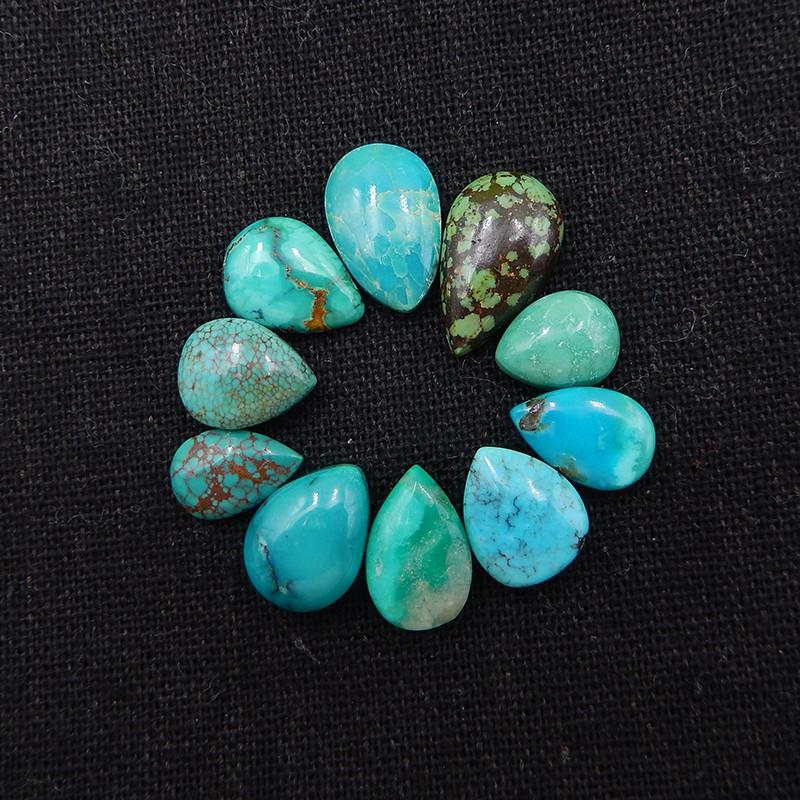
Turquoise yɛ nea ɛtaa yɛ bruu a ɛyɛ ahabammono a ɛnyɛ hann a wɔtaa hu a ntini kɔkɔɔ anaa bruu wɔ mu. Edin no fi Fransefo turquois , a ɛkyerɛ “Turkeyfo” mu, efisɛ Europafo nam Turkeyfo aguadi akwan so nyaa ɔbo no.
Kɔla a ɛyɛ ahabammono ne bruu a wɔde afrafra a ɛda nsow no na ɛkanyan kɔla “turquoise.” Nanso, abo a ɛyɛ turquoise betumi afi bruu a ɛhyerɛn so akosi ahabammono so ankasa.
Hwɛ yiye: wɔde kɔla gu abo a ɛyɛ turquoise a ɛba fam pii mu anaasɛ wɔma ɛyɛ den sɛnea ɛbɛyɛ a ɛbɛyɛ kɔla a eye. Wobetumi atɔn abo afoforo sɛ nea wɔasuasua, a emu pii yɛ howlite a wɔde kɔla ayɛ anaasɛ magnesite , abo abien a ɛyɛ fitaa a efi awosu mu a ɛwɔ nhama anaa ntini a ɛte sɛ turquoise de no.
Zircon a ɛyɛ bruu

Nea ɛde yɛn din no ano ne zircon bruu a wɔmfa nyɛ hwee, abɔde mu ɔbo a wɔtaa de frafra cubic zirconia a wɔayɛ no . Sɛ nea zircon yɛ ade a akyɛ sen biara a wonim wɔ Asase so da nkyɛn a, ɛyɛ nwonwa nso sɛ ɛwɔ apete kɛse sen daimond a ne bo yɛ den no fã ketewaa bi.
Kɔla a agye din sen biara, anyinam ahoɔden bruu zircon, de kae December awodadi ne ayeforohyia afe a ɛto so 4. Zircon bruu betumi ayɛ abɔde, nanso wɔtaa de ɔhyew yɛ ho adwuma ma ɛyɛ bruu.
Efi Wim kosi Po so no, Blue Gemstone a Wobɛpaw no Adɔɔso!
Aboɔden abo a ɛyɛ bruu a egu ahorow no sõ. Ɛnam ase nnyigyei ahorow, saturation levels, ne bo nsɛntitiriw nti, akyinnye biara nni ho sɛ wubenya ɔhokafo bruu a ɔyɛ pɛ ama wo!
Hwehwɛ aboɔden abo a ɛyɛ bruu ɔhaha pii wɔ Gem Rock Auctions nnɛ!
搜尋Gemstone Encyclopedia
相關拍賣
相關文章
Obiara wɔ aboɔden abo a ɛne ne nsoromma agyiraehyɛde hyia. Wɔsan frɛ eyinom sɛ wo Nsoromma Abo. Sua pii fa saa abo yi ho na hwehwɛ nea wo Nsoromma Abo no yɛ.
10th May 2018
Mfiase no na wɔde Awo Abo anaa aboɔden abo no bata nsoromma mu hwɛ anaa ɔsram a ankorankoro bi awo ho. Hwehwɛ nea wo bo no yɛ na hwɛ abo a yɛwɔ sɛ yɛtɔn no
8th Feb 2021
Gem Rock Auctions wɔ Certified Gemstones a ɛso sen biara wɔ intanɛt so no mu biako. Hwehwɛ aboɔden abo sɔhwɛ afiri a wɔapene so yi mu.
24th Jul 2018
最新的文章
Chrysanthemum nhwiren abo yɛ abɔde mu anwonwade a ɛwɔ calcite, celestite, anaa andalusite nhwiren fitaa bi a wɔde asisi limestone tuntum anaa atɛkyɛ abo so.
13th Jan 2026
Rainbow lattice sunstone yɛ feldspar ahorow a ɛwɔ optical nsunsuanso abiɛsa fɛfɛ a efi nneɛma ahorow a wɔde ka ho a ɛwɔ hɔ no mu ba. Ɛyɛ ogya kɔla display ne lattice nsusuwso ma ɛyɛ coletor abohene a wɔntaa nhu!
12th Jan 2026
Thulite yɛ Norwayfo aboɔden abo a wɔntaa nhu a ɛda rosy hue a ɛyɛ hyew a efi zoisite mineral abusua a wɔtaa de di dwuma wɔ agude tebea ne pendants mu adi.
6th Jan 2026
文章類別
How To's is where you will find helpful articles from gem Rock Auctions on how to cut gemstones, select gemstones and buy gemstones.
9文章





![33.1 CTS A GRADE NATURAL BUMBLE BEE JASPER [ST9769]](https://liveplatforms-production.b-cdn.net/tenants/gr/uploads/images/515000-519999/516655/55b59724dea5a.JPG?width=480&aspect_ratio=1001%3A1000)
![STUNNING A GRADE BUMBLEBEE JASPER 10.33 CTS [MX9432]](https://liveplatforms-production.b-cdn.net/tenants/gr/uploads/images/230000-234999/234199/234199_1312871458.jpg?width=480&aspect_ratio=1001%3A1000)

